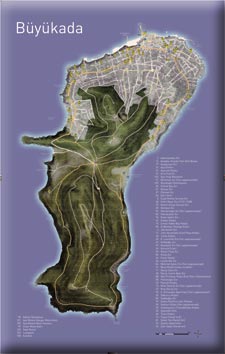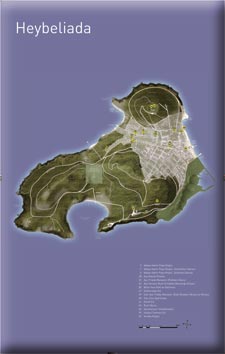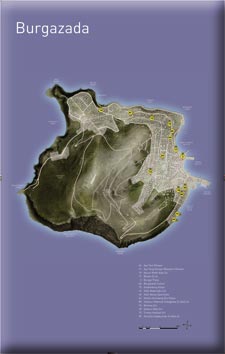Princes’ Islands
Brief Info On The Islands
- Details
- Created on 16 February 2013
- Last Updated on 01 April 2013
Islander
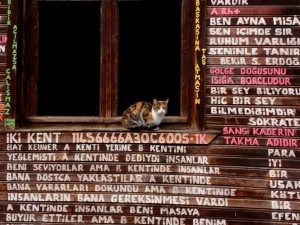 GONZALO: Had I plantation of this isle, my lord,
GONZALO: Had I plantation of this isle, my lord,
ANTONIO:He’ld sow’t with nettle-seed.
SEBASTIAN: Or docks, or mallows.
GONZALO: And were the king on’t, what would I do?
SEBASTIAN: Scape being drunk for want of wine
GONZALO: I’ the commonwealth I would by contraries Execute all things; for no?kind of traffic Would I admit; no name of magistrate; Letters should not be known; riches, poverty, And use of service, none; contract, succession, Bourn, bound of land, tilth, vineyard, none; No use of metal, corn, or wine, or oil; No occupation; all men idle, all; And women too, but innocent and pure; No sovereignty.
Shakespeare,
The Tempest
Serenity
Automotive transport is banned at the Islands, except for a few municipal vehicles. Otherwise the only means of transport on Burgazada, Heybeliada and Büyükada is by fayton, or horse-drawn carriage, while on Kınalıada one must either walk or ride a bicycle.
Nature
"Nature, insatiable in giving, has diversified the capital not only with the Bosphorus and the Golden Horn, but with the tiny archipelago of the Princes’ Isles. More than Ischia and Capri are to Naples, are Khalki, Prinkipo and their sister islands to Constantinople.
Nothing more ideal can be pictured than the loveliness of these islands in May and June. The hills are covered with pine forests, and the meandering shores are indented with shaded and sequestered bays.
Edwin Grosvenor -1895
 ““The sea, at a far away shore was set ablaze like a crimson bouquet. I have carved all the details in my mind with a strange intuition. A cutter with pale yellow sails adorned this view for an instance. Then that cruiser sailed out of the sea burning up in flames, and disappeared into the blue.
““The sea, at a far away shore was set ablaze like a crimson bouquet. I have carved all the details in my mind with a strange intuition. A cutter with pale yellow sails adorned this view for an instance. Then that cruiser sailed out of the sea burning up in flames, and disappeared into the blue.
The colors blazed for the last time, and the sun charred for the last time. The mansions midst of their gardens glowed with the last rays, looking more like fake showpiece cakes on pastry shop windows. The walls of the gardens were low and painted in whitewash.”
The mimosa, silk trees, exuberant hibiscuses on the ramps of the Island hills created an extraordinary shower of reverie. And all surrendered their yellow, pale pink, white and purple flowers to the light breeze.”
Selim İleri,
Fantasy and Pain
Secluded Life, Inaccessibility
“Because I live a total secluded life on top of a mountain, visiting my house cannot be compared to visits in the city. Therefore I see it necessary to make some explanation: Th real door of the residence is on the west side; but it is kept locked with chains because it is located at a spot where even goats would have trouble climbing. We opened a henhouse door on the east side, so we enter and exit from there. However there is neither a door bell nor a knocker... Neither a bell nor a rattle... One must pick up a large rock and start hitting as hard as possible until the door wears down with the thought that it has a penance to pay. Because there isn’t a person inside that can hear the first knocks. Some visitors head back without being able to make themselves heard; I have benefited from this primitive deaf door considering my asocial life.”
From the letter of Hüseyin Rahmi sent to Refik Ahmet Sevengil
Sightseeing
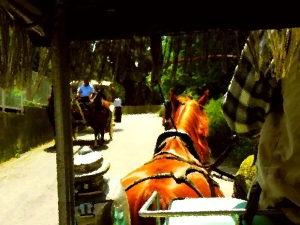 One day the weather was really hot, we were staying on the island with my five year old daughter Rüya and we decided?to go sightseeing on a horse drawn buggy.?I sat backwards in the carriage and my daughter right in front of me. She would be facing the direction we were heading. We passed through gardens with flowers, low walls, wooden houses and vegetable gardens. I was looking at the facial expressions of my daughter as the carriage pattered on, wondering what she saw in the world...
One day the weather was really hot, we were staying on the island with my five year old daughter Rüya and we decided?to go sightseeing on a horse drawn buggy.?I sat backwards in the carriage and my daughter right in front of me. She would be facing the direction we were heading. We passed through gardens with flowers, low walls, wooden houses and vegetable gardens. I was looking at the facial expressions of my daughter as the carriage pattered on, wondering what she saw in the world...
Things, objects, trees, walls, posters, writings, streets, cats. Asphalt. Hot. As hot as it can be...
We went through the forest but the forest wasn’t cool either. It was like as if heat was coming out of it. The horses really slowed down as the hill began to become steeper.
We could hear the crickets. The carriage was going really slow and the path became very narrow by the pines, then suddenly we saw a view.”
The driver said ‘Brrrs’ and the horses stopped. He said ‘Let them rest’.
We stopped and enjoyed the scenery... There was a cliff at our side. And below were rocks, the sea, and the other islands buried inside a mist.”
Orhan Pamuk,
Other Colours
A Day In The Island
“The sun had descended more now, and the seagulls are singing like crazy, cormorants are getting out of the water and flapping their wings like crazy to accelerate. The sea is still calm besides the waves hitting the shores of Sivriada just ahead.
We row towards Sivri and land the boat on the shore with peeblestone (...) A single small purple light is ecstatically dancing on the bay. And then it gets dark. The lighthouse of Yassıada starts to operate and sparkles?once in every two minutes. A sail has set sail, coming from a distance.
First of all we slurp the sea urchins. Karayan puts a can on top of the rocks surrounding the fire, scrubs the fish with oil and garlic, stuffs the fresh fennel in their stomachs and lies them down on the heated can. A strong sizzle is heard.”
Exile
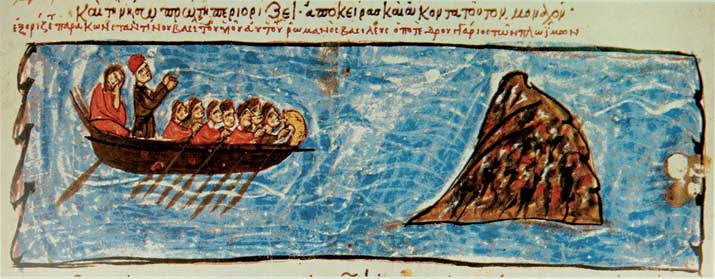
Romanus IV Diogenes (r. 1067-71) was deposed in 1071 after his catastrophic defeat by the Seljuk Turks at the battle of Manzikert. His successor, Michael VII Doucas (r. 1071-8), blinded Romanus and exiled him to the monastery of the Transfiguration on Proti, where he died on 4 August 1072.
Life
August 11th 2005, Thursday, 06.35
İstanbul from a thin, long and wooden balcony.
June 25th, around 07.00
I could not tell if it was the sunlight that woke me up this morning, or the crazy chorus practice of seagulls.
July 19th, 07.30
A walk in the afternoon and one at?night is both unusual and natural, and this enabled us to load the two islands, and the inner impressions generated from the two islands on to our scales.
September 3rd, 07.00
In the end we stayed, delaying the?return to this evening – it is good that we did so: putting aside the rheumatism pains that are driving me crazy; we spent another wonderful day on the island. October
October 14th, 07.50
Island = Isola. At last, the island is left to the islanders.
Enis Batur,
The Island Notebooks
Music
When Ahmet Rasim’s wife was seeing him off on the morning following a night of turning up late, she asked him not to be late saying, “Mind you don’t be late, I can’t take it anymore, be here before the night falls”. On the island ferry Rasim wrote lyrics for his wife’s complaint and his friend Tatyos Efendi composed this unforgettable song:
“Come before nightfall?Be early, don’t be late?I cannot stand it anymore Be early, don’t be late”
Poem
If you were to pass by the shore of Kumkapı
a) you would dream of having a delicious fish meal
b) you would want to walk on water to the Islands
c) you would think how fast life goes by
d) you would remember you owed Agop five lira
Zahrad
Sunset
 “From whom did the kid from Kars hear this song; from where, when did he learn it, I don’t know...
“From whom did the kid from Kars hear this song; from where, when did he learn it, I don’t know...
But even when half a century and another ten years has passed, I still remember it like it was today, murmuring the song ‘I Am Waiting On The Shores of The Island’ in tears, sitting against the sunset on the wide, concrete old window of the Club Birlik, that’s still in its proper place today at the point where our house was where Halit Paşa Street and Atatürk Street intersects...
What was it in the song that affected me? Is it the tune that I still love today??Is it the touching lyrics??Is it the tremendous sunset that fades from red to pink?”
Ataol Behramoğlu,
My Princes’ Islands
Memoirs
“It was a very hot summer day, a terribly hot day; I could not manage to sleep at home. There were wooden benches in the garden, I quickly went to one of them. I realized that my father was lying down on one of them; it was obvious that he couldn’t sleep either. ‘Is that you, girl?’ he said, ‘Come and lie down.’ We watched the stars together, me on one bench and my father on the other. My father began to talk about the stars, he told me their Persian names, and explained endlessly their paths.”
From the memoirs of Ela Güntekin
Vicinity
“In my childhood, Nizam Street was considered to be one of the most elegant and European styled vicinity of Büyükada, and was also one of the relatively more liberated places in İstanbul. Lined up on this road,?in small and large gardens, were luxurious mansions belonging to wealthy families local and foreign, whom people always talked about and whose names turned up in the papers daily. Mansions, one more beautifully adorned and spectacular than the other... So much so that, as you walked pass by them the street seemed to allude to a more delicate and more nonchalant state at every step."
Abdülhak Şinasi Hisar,
Ali Nizami Bey’s Occidentalism and Sheikhdom
Pleasure
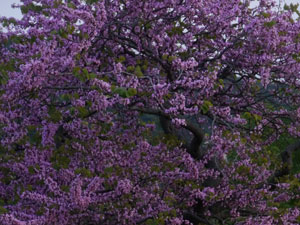 “We finally rented a house and went to Burgaz. The house had an old style and a wide sofa, wisteria and a garden covered with roses and honeysuckles. Life totally changed for me there. I felt as if I was living in the house in Beşiktaş. It was situated on top of?a steep slope. The facade of the house was covered in pines all the way to the sea, and sandy beach below. I used to gaze at the blue sea from its windows.
“We finally rented a house and went to Burgaz. The house had an old style and a wide sofa, wisteria and a garden covered with roses and honeysuckles. Life totally changed for me there. I felt as if I was living in the house in Beşiktaş. It was situated on top of?a steep slope. The facade of the house was covered in pines all the way to the sea, and sandy beach below. I used to gaze at the blue sea from its windows.
I went there sick, but found my spiritual balance as well as physical. I lived among?the beauty and daily pleasures given to man through nature. In the mornings, the kids with their nanny and I with the cook; we would climb up to the pine groove on top?of donkeys, and I used to eat, drink and virtually live there all day long.”
Halide Edip Adıvar,
The House With Purple Wisteria, (Memoirs of Halide Edip)
Climate
- Details
- Created on 16 February 2013
- Last Updated on 01 April 2013
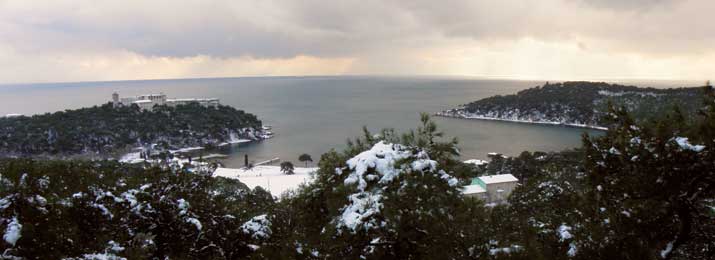
The Princes’ Islands generally enjoy milder weather than central Istanbul. In summer, island temperatures range from a daytime high of 28º Celsius to a nighttime low of 20° C. The summer sky is usually clear, though after August 15 there may be occasional rainfall. The water temperature of the Sea of Marmara averages 22° C during the summer.
September and October are the loveliest months on the islands. After the middle of September, the average temperature decreases to 25º C with some light rain. During the winter months (December through March), harsh northern winds may bring colder temperatures, but the sunny days are perfect for an enjoyable winter outing.
In April and May, the islands are a paradise of greenery with high temperatures between 18 and 22º C.

Nature of the Princes' Islands
- Details
- Created on 17 February 2013
- Last Updated on 01 April 2013
The Vegetations of Princes' Islands
Meditarrean and Black Sea climates’ characteristics and vegetation can be found together in Princes Islands. Besides the residential areas, the vegetation of the island today is pinus brutia (kızılçam) and maquis of the Mediterranean whereas exotic plants are dominating the residential ares and gardens.
Pinus Brutia
It’s a matter of discussion whether the Pinus Brutia is the natural vegetation of the Islands or not as the photos from the 19th century depict pinus brutia plantation in some parts of the island, while at the same time, some parts are treeless. Artemidorus, who lived in 1st and 2nd centuries B.C, talks about the Princes Island as Pityodes (Çamlık).
Maquis
Maquis are the characteristic plant association of the Mediterranean climate and they form a group under different names. For instance, while they can be named as tall maqui or short maqui, they can also be referred by its dominant type.
Exotic Plants
In all of the Islands, exotic (yabancıl) plants stand out around the residential areas, gardens, parks and roadsides. They capture quite a lot of attention by their intriguing kinds especially in the gardens of historical villas and mansions. Besides the plants representing the mystical nature of Anatolia and Far East, plants special to South America and Japan are also seen.
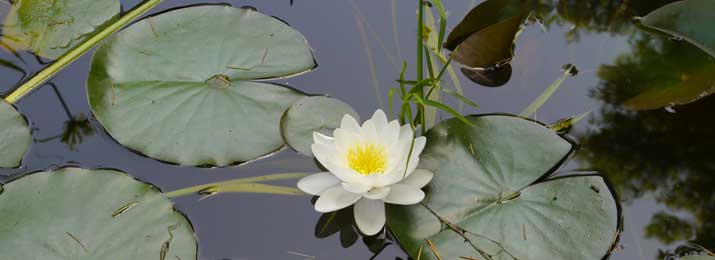
Princes' Islands
- Details
- Created on 17 February 2013
- Last Updated on 01 April 2013
Princes' Islands
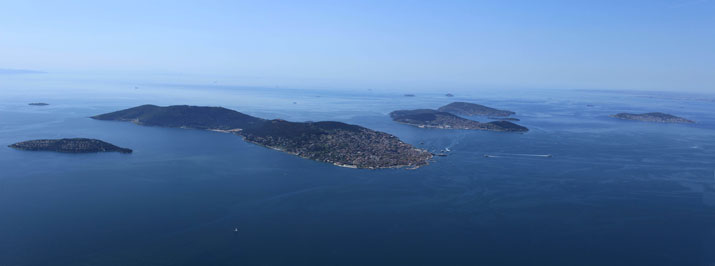
The Princes’ Isles, known in Turkish as Adalar, or the Islands, are a little archipelago off the Asian coast of the Sea of Marmara southeast of the southern end of the Bosphorus. The isles have always been a maritime suburb of Istanbul, the great metropolis on the Bosphorus, Greek Constantinople, ancient Byzantium. The group consists of nine islands, all but four of them tiny and sparsely inhabited. The nearest is some fifteen kilometers from the ferry terminal in Istanbul at the confluence of the Golden Horn and the Bosphorus, the farthest about twenty-six kilometers, though in spirit they seem at a far greater remove than that, since they are so different in appearance and atmosphere from the imperial city on their western horizon.
Nine İslands

Ferries stop in turn at the four principal isles, the closest of which is Kınalıada ( known to the Greeks as Proti), followed by Burgazada (Antigoni), Heybeliada (Halki), and finally Büyükada (Prinkipo), the largest and most populous of the isles. During the summer months ferries also stop at Sedefadası (Antirovithos). There are a few summer residents on Kaşıkadası (Pita), but Tavşanadası (Neandros), Yassıada (Plati) and Sivriada (Oxia) are uninhabited, except for a single hermit now living on the latter isle.
Büyükada (Prinkipo)
Büyükada, the Greek Prinkipo, is the largest and most beautiful of the Princes’ Isles. This is the only one of the islands that most people visit and it is the summer resort par excellence.
With an area of 5.4 square kilometers, Büyükada is larger than the other three major islands combined. It is also the most populous of the islands, with about 6,500 residents year-round and some 40,000 in the summer.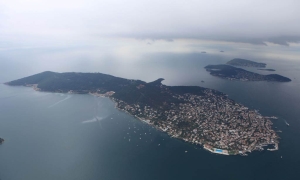
The island is about 4.3 kilometers long from north to south and averages about 1.3 kilometers in width from east to west. It has two lofty hills: Isa (Hristos or Christ) Tepesi, to the north, rising to a height of 164 meters, and to the south Yüce Tepe (Great Hill), known to the Greeks as Hagios Georgios (St. George), with an elevation of 202 meters, the highest peak in the Princes’ Isles. The two hills are separated in the middle of the island by a broad valley, known to the Greeks as Diaskelo. The northernmost part of the island is now completely built up, but farther south are lovely pine groves and other forests, wild cliffs plunging into the sea, and isolated sandy coves.
Heybeliada (Halki)
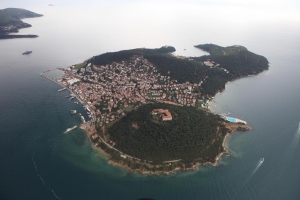 Heybeliada is the second largest of the islands, with an area of 2.35 square kilometers. It has a year-round population of about 5,500, which in summer increases to some 30,000. Halki, the Greek name of the island, which means "copper," comes from the copper mines that were worked here in antiquity, mentioned by Aristotle. The island took its Turkish name, Heybeli, from the word for saddlebag, heybe, which it is said to resemble because of the shape of its hills and their intervening valleys.
Heybeliada is the second largest of the islands, with an area of 2.35 square kilometers. It has a year-round population of about 5,500, which in summer increases to some 30,000. Halki, the Greek name of the island, which means "copper," comes from the copper mines that were worked here in antiquity, mentioned by Aristotle. The island took its Turkish name, Heybeli, from the word for saddlebag, heybe, which it is said to resemble because of the shape of its hills and their intervening valleys.
The hills are Ümit Tepesi, formerly known as Papaz Dağı (85 m.), in the north of the island, Değırmen Tepesi (136 m.) and Köy Tepesi (128 m.) in the center, and Baltacıoğlu Tepesi (98 m.) in the southwest. The core of the village is on the northeast shore, from where its houses spread in tiers along the slopes of Ümit Tepesi, Değirmen Tepesi, and Köy Tepesi and the valleys between them.
Burgazada (Antigoni)
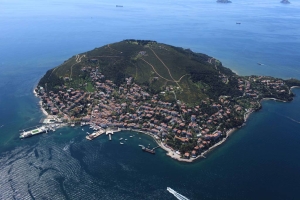 Burgazada is the third largest island in the archipelago, with an area of 1.5 square kilometers. It has a year-round population estimated at 1,500, which in summer increases to about 15,000.
Burgazada is the third largest island in the archipelago, with an area of 1.5 square kilometers. It has a year-round population estimated at 1,500, which in summer increases to about 15,000.
In antiquity the island was known as Panormos, but in Byzantine times it was called Antigoni, the name still used by the Greeks. The Turkish name of Burgaz is a corruption of the Greek pyrgos, or tower, from an ancient watchtower on its summit that is mentioned by Evliya Çelebi and other travelers up until the early nineteenth century. The watchtower can be seen on the summit of the island in an engraving done in 1794 by Cosimo Comidas. The engraving shows the island bare except for what appear to be an orchard and two or three cultivated patches on the side of the hill.
The single hill, Hristos Tepesi (Christ Hill), also known as Bayraktepe (Flag Hill), rises to a height of 170 meters in the middle of the island. The center of the village is on the northeast coast of the island, its houses stretching from there along the heights above the northern shore. The shore roads extend around all of the island except its inhospitable south coast, where precipitous cliffs hang over the sea.
Kınalıada (Proti)
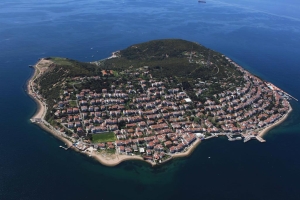 It is the smallest of the four major islands, with an area of 1.356 square kilometers. The island takes its Turkish name, which means "henna-red," from the color of the sandstone cliffs that plunge into the sea at its eastern end. The Greeks have always called the island Proti, or First, since it is the nearest of the islands to the city.
It is the smallest of the four major islands, with an area of 1.356 square kilometers. The island takes its Turkish name, which means "henna-red," from the color of the sandstone cliffs that plunge into the sea at its eastern end. The Greeks have always called the island Proti, or First, since it is the nearest of the islands to the city.
Kınalıada has three peaks, with Çınar Tepesi (Plane Tree Hill) rising in the northeast of the island to an elevation of 115 meters, Teşrifiye Tepesi (110 m.) in the center, and Manastır Tepesi (93 m.) in the south.
The island has a winter population of some 1,000, while in summer the number increases to about 15,000. The village spreads around the north and east sides of the island, sloping down in tiers along the slopes of the three hills. The focal point of the village, here as in the other three major isles, is the vapur iskelesi, or ferry landing, on the northeast shore. The new iskele for the sea bus is just beside the pier for the regular ferry on its south side.
Sedefadası (Antirovithos)
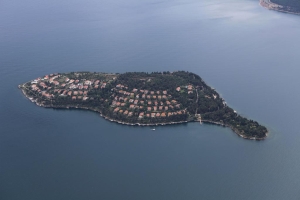 Sedefadası, the Greek Antirovithos, is about 1,200 meters east of the central part of Büyükada. Sedef is the fifth largest of the isles, measuring 680 by 250 meters, its highest point fifty-five meters above sea level. The name of the island is said to derive either from sedef (mother-of-pearl) or from sedefotu, the rue plant commonly found here.
Sedefadası, the Greek Antirovithos, is about 1,200 meters east of the central part of Büyükada. Sedef is the fifth largest of the isles, measuring 680 by 250 meters, its highest point fifty-five meters above sea level. The name of the island is said to derive either from sedef (mother-of-pearl) or from sedefotu, the rue plant commonly found here.
Sedefadası is served by ferry from mid-June to mid-September. Those who are not residents or their guests are not allowed to enter the gated community, but are restricted to a restaurant above the iskele and a pebble beach along the shore to the right of the landing stage. The most beautiful part of the island is its eastern shore, which is luxuriantly wooded with cypresses and umbrella pines as well as a rich variety of other trees.
Sivriada (Oxia) and Yassıada (Plati)
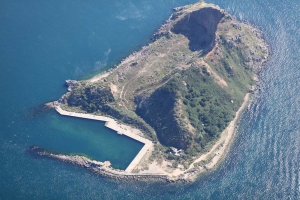 Sivriada and Yassıada are off to the west of the other islands of the archipelago, sixteen to seventeen kilometers south of the entrance to the Bosphorus and fifteen kilometers off the Asian coast. They can be reached by hiring a motor boat at any of the major islands.
Sivriada and Yassıada are off to the west of the other islands of the archipelago, sixteen to seventeen kilometers south of the entrance to the Bosphorus and fifteen kilometers off the Asian coast. They can be reached by hiring a motor boat at any of the major islands.
 The Greek name of Sivriada is Oxia and that of Yassıada is Plati. Sivriada, which is about two kilometers to the northwest of Yassıada, is somewhat the smaller of the two, but it is more noticable because its peak is more than twice as high as that of the other isle. The Turkish and Greek names are descriptive and mean the same thing in each case: Sivri-Oxia meaning "Pointed" and Yassı-Plati meaning "Flat." Yassiada was also known as Hayırsızada (Useless Island), a name still used by some local residents.
The Greek name of Sivriada is Oxia and that of Yassıada is Plati. Sivriada, which is about two kilometers to the northwest of Yassıada, is somewhat the smaller of the two, but it is more noticable because its peak is more than twice as high as that of the other isle. The Turkish and Greek names are descriptive and mean the same thing in each case: Sivri-Oxia meaning "Pointed" and Yassı-Plati meaning "Flat." Yassiada was also known as Hayırsızada (Useless Island), a name still used by some local residents.
Tavşanadası (Neandros)
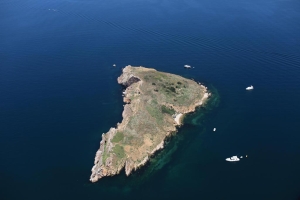 Tavşanadası, or Rabbit Island, known to the Greeks as Neandros, is some two kilometers off the southernmost point of Büyükada, from which it can be reached by hiring a motor boat at the iskele. It is the second smallest of the isles, after Kaşıkadası, with an area of 10,000 square meters, its highest point forty meters above sea level.
Tavşanadası, or Rabbit Island, known to the Greeks as Neandros, is some two kilometers off the southernmost point of Büyükada, from which it can be reached by hiring a motor boat at the iskele. It is the second smallest of the isles, after Kaşıkadası, with an area of 10,000 square meters, its highest point forty meters above sea level.
It is once known to both Turks and Greeks as Neandros, the most remote of the Princes’ Isles from Istanbul. The most beautiful part of the island is its southern shore, which is formed by a rock cliff that plunges sheer into the sea, with myriads of cormorants and seagulls perched like sentinels on its crags.
Vordonos Adası (Vordonosi)
About midway between Kınalıada and the Asian coast there is a tiny islet called Vordonosadası, which is sometimes included as a part of the archipelago. Tiny though it is, it too was the site of a Byzantine monastery, founded in the second half of the ninth century by the patriarch Photius. The ruins of the monastery can still be seen on the island, whose only other monument is a lighthouse.
The Current And Potential Situation Of The Princes’ Islands As A Destination For Special Events And Boutique Meetings
- Details
- Created on 01 December 2013
- Last Updated on 20 July 2014
A gruop of students from Tourism Administration Department of Boğaziçi University prepared a thesis about the tourism potential of the Princes' Islands. The summary of the thesis which has the title "The Current And Potential Situation Of The Princes’ Islands As A Destination For Special Events And Boutique Meetings" is given below. The complete thesis can be downloaded from the link at the bottom.
Event tourism, especially special events and boutique meetings, has an increasing attractiveness in terms of tourism. It may also contribute to the development of the Princes’ Islands by decreasing the seasonality problem of the destination and increasing the variability of the tourism products. The purpose of this study is to analyze the current situation and the potential of the Princes’ Islands as a destination for special events and boutique meetings. The current situation and potential was taken into consideration in relation to the conceptual model that includes available facilities and investments, attractions, heritage sites and activities, protective measures, support and collaboration, cost of destination and perceived potential impacts.
The studyis descriptive, non-contrived and a field study. Judgmental and snowball sampling were used and semi-structured interviews to hotels which have meeting room facilities, event organization companies, NGOs, the Municipality of the Princes’ Islands, and the Anadolu Club were conducted.
The findings show that the Islands have a potential for special events and boutique meeting. However, the Islands need to improve their facilities and investment, establish a professional relationship and coordination between different stakeholders, including the Metropolitan Municipality, local authorities, organization firms and hotels, in order to create and increase alternative activities and develop the Princes’ Islands as a destination for special events and boutique meetings.
Please clich here to download the thesis.



